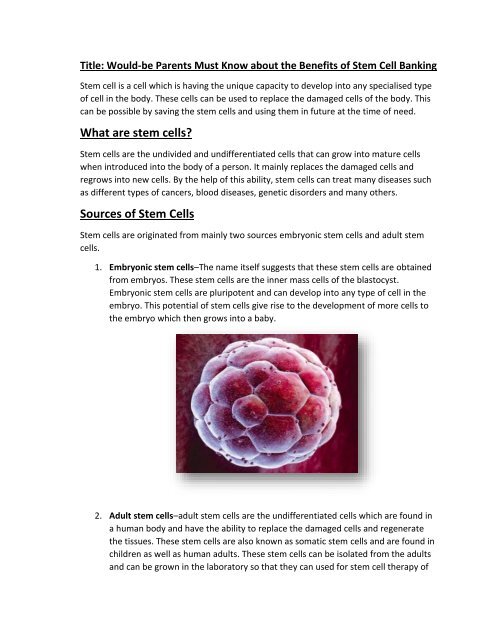Would-be Parents Must Know about the Benefits of Stem Cell Banking
The stem cell is a cell which is having the unique capacity to develop into any specialized type of cell in the body. These cells can be used to replace the damaged cells of the body. This can be possible by saving the stem cells and using them in the future at the time of need.
The stem cell is a cell which is having the unique capacity to develop into any specialized type of cell in the body. These cells can be used to replace the damaged cells of the body. This can be possible by saving the stem cells and using them in the future at the time of need.
You also want an ePaper? Increase the reach of your titles
YUMPU automatically turns print PDFs into web optimized ePapers that Google loves.
Title: <strong>Would</strong>-<strong>be</strong> <strong>Parents</strong> <strong>Must</strong> <strong>Know</strong> <strong>about</strong> <strong>the</strong> <strong>Benefits</strong> <strong>of</strong> <strong>Stem</strong> <strong>Cell</strong> <strong>Banking</strong><br />
<strong>Stem</strong> cell is a cell which is having <strong>the</strong> unique capacity to develop into any specialised type<br />
<strong>of</strong> cell in <strong>the</strong> body. These cells can <strong>be</strong> used to replace <strong>the</strong> damaged cells <strong>of</strong> <strong>the</strong> body. This<br />
can <strong>be</strong> possible by saving <strong>the</strong> stem cells and using <strong>the</strong>m in future at <strong>the</strong> time <strong>of</strong> need.<br />
What are stem cells?<br />
<strong>Stem</strong> cells are <strong>the</strong> undivided and undifferentiated cells that can grow into mature cells<br />
when introduced into <strong>the</strong> body <strong>of</strong> a person. It mainly replaces <strong>the</strong> damaged cells and<br />
regrows into new cells. By <strong>the</strong> help <strong>of</strong> this ability, stem cells can treat many diseases such<br />
as different types <strong>of</strong> cancers, blood diseases, genetic disorders and many o<strong>the</strong>rs.<br />
Sources <strong>of</strong> <strong>Stem</strong> <strong>Cell</strong>s<br />
<strong>Stem</strong> cells are originated from mainly two sources embryonic stem cells and adult stem<br />
cells.<br />
1. Embryonic stem cells–The name itself suggests that <strong>the</strong>se stem cells are obtained<br />
from embryos. These stem cells are <strong>the</strong> inner mass cells <strong>of</strong> <strong>the</strong> blastocyst.<br />
Embryonic stem cells are pluripotent and can develop into any type <strong>of</strong> cell in <strong>the</strong><br />
embryo. This potential <strong>of</strong> stem cells give rise to <strong>the</strong> development <strong>of</strong> more cells to<br />
<strong>the</strong> embryo which <strong>the</strong>n grows into a baby.<br />
2. Adult stem cells–adult stem cells are <strong>the</strong> undifferentiated cells which are found in<br />
a human body and have <strong>the</strong> ability to replace <strong>the</strong> damaged cells and regenerate<br />
<strong>the</strong> tissues. These stem cells are also known as somatic stem cells and are found in<br />
children as well as human adults. These stem cells can <strong>be</strong> isolated from <strong>the</strong> adults<br />
and can <strong>be</strong> grown in <strong>the</strong> laboratory so that <strong>the</strong>y can used for stem cell <strong>the</strong>rapy <strong>of</strong>
<strong>the</strong> patient. The adult stem cells can <strong>be</strong> extracted from any part <strong>of</strong> <strong>the</strong> body but<br />
<strong>the</strong> richest source <strong>of</strong> adult stem cells is <strong>the</strong> bone marrow.<br />
However, both <strong>of</strong> <strong>the</strong>se above sources are mostly prohibited by <strong>the</strong> medical specialists<br />
due to <strong>the</strong> following reasons:<br />
• The embryonic stem cells are needed for <strong>the</strong> growth <strong>of</strong> <strong>the</strong> baby so if those stem<br />
cells are collected <strong>the</strong>n <strong>the</strong>re is achance <strong>of</strong> getting an underdeveloped baby.<br />
• On <strong>the</strong> o<strong>the</strong>r hand, when <strong>the</strong> adult stem cells are used for stem cell <strong>the</strong>rapy <strong>the</strong>n<br />
<strong>the</strong>re are chances <strong>of</strong> getting <strong>the</strong> infection <strong>of</strong> Cytomegalo Virus (CMV) and may also<br />
cause graft vs host disease that leads to rejection <strong>of</strong> stem cells.<br />
So, <strong>the</strong> medical experts <strong>the</strong>n researched and found that umbilical cord blood also contains<br />
stem cells that can <strong>be</strong> extracted and stored for future use.<br />
Cord blood stem cells – Cord blood is <strong>the</strong> richest source <strong>of</strong> hematopoietic stem cells<br />
which are <strong>the</strong> basic cells <strong>of</strong> blood and immune system. They have <strong>the</strong> capability that <strong>the</strong>y<br />
can regenerate <strong>the</strong>mselves into any type <strong>of</strong> cells <strong>of</strong> <strong>the</strong> body. This helps <strong>the</strong>m to repair <strong>the</strong><br />
damaged tissues, blood vessels and organs <strong>of</strong> <strong>the</strong> body. This regenerating property makes<br />
<strong>the</strong> stem cells able to treat various life-threatening diseases. In addition, <strong>the</strong>re are many<br />
advantages as compared to o<strong>the</strong>r stem cells such as it is easily available, collection<br />
procedure is safe and risk-free, gets perfectly matched with <strong>the</strong> recipient, do not possess<br />
any type <strong>of</strong> rejection and also do not have <strong>the</strong> chances <strong>of</strong> getting any kind <strong>of</strong> infection.
Method <strong>of</strong> collection and storage<br />
Once your baby is born and separated, <strong>the</strong> umbilical cord is clamped and <strong>the</strong>n <strong>the</strong> cord<br />
blood is collected in a single-use sterile 250mL blood bag. This cord blood along with cord<br />
tissue and mo<strong>the</strong>r’s blood sample is <strong>the</strong>n kept in <strong>the</strong> Kit box which is transported to <strong>the</strong><br />
storage laboratory by maintaining a controlled temperature. In <strong>the</strong> laboratory, <strong>the</strong> cord<br />
blood is processed by an advanced automated technology known as AXP®II for harvesting<br />
hematopoietic stem cells. These stem cells are <strong>the</strong>n stored in compartmentalized<br />
cryopouches at -190°C in liquid nitrogen.
What is stem cell banking?<br />
<strong>Stem</strong> cell banking is <strong>the</strong> method <strong>of</strong> extraction, processing and storage <strong>of</strong> stem cells. This<br />
storage facility is known as stem cell bank where <strong>the</strong> cord blood stem cells <strong>of</strong> a newborn<br />
baby is stored for future use.<br />
<strong>Banking</strong> <strong>of</strong> <strong>the</strong> cord blood is a procedure <strong>of</strong> preserving <strong>the</strong> stem cells which is generally<br />
thrown away after <strong>the</strong> birth <strong>of</strong> a baby. Regarding cord blood parents have three options –<br />
store <strong>the</strong>m in a private bank by paying fee, donate <strong>the</strong> cord blood to public bank or you<br />
can throw <strong>the</strong>m as a medical waste. In all <strong>of</strong> <strong>the</strong>se options saving your baby’s stem cells in<br />
a private bank is <strong>the</strong> <strong>be</strong>st option as it will give you <strong>the</strong> ability to own your sample stem<br />
cells.<br />
Types <strong>of</strong> <strong>Stem</strong> <strong>Cell</strong> Bank<br />
There are mainly two types <strong>of</strong> stem cell bank – Private cord blood bank and public cord<br />
blood bank<br />
Private cord blood bank - In private cord blood banking, parents have to pay for storing <strong>the</strong>ir<br />
baby’s cord blood. This cord blood stem cells can <strong>be</strong> used in future by <strong>the</strong> baby as well as its<br />
family mem<strong>be</strong>rs such as siblings, parents or grandparents. In this type <strong>of</strong> bank, <strong>the</strong> family will<br />
own <strong>the</strong> cord blood and only <strong>the</strong>y can make decisions <strong>about</strong> what to do with <strong>the</strong>ir sample.<br />
Public cord blood bank - In public cord blood banking, <strong>the</strong> cord blood sample <strong>of</strong> <strong>the</strong> baby is donated<br />
to <strong>the</strong> cord blood bank where it can <strong>be</strong> stored and is given to any patient who is in need <strong>of</strong> transplant<br />
and can also <strong>be</strong> used in doing medical research.<br />
Difference <strong>be</strong>tween private and public bank<br />
Private bank<br />
Public bank<br />
Proposed Use<br />
Preserved for both <strong>the</strong> baby and its<br />
family mem<strong>be</strong>rs for treating more<br />
than 80 diseases such as cancers<br />
and any blood related diseases.<br />
Donated by <strong>the</strong> parents for <strong>the</strong><br />
patient who needed stem cell<br />
treatment to cure any lifethreatening<br />
disease. Also, available<br />
for medical research for treating<br />
various medical conditions.
Rights<br />
Complete right to own <strong>the</strong> stem<br />
cells as well as immediate access is<br />
provided to <strong>the</strong> clients when <strong>the</strong>y<br />
save <strong>the</strong>ir baby’s stem cells in a<br />
private bank.<br />
Once donated <strong>the</strong> parents or <strong>the</strong><br />
baby do not have <strong>the</strong> right to own<br />
<strong>the</strong>ir sample stem cells.<br />
Collection and<br />
transportation<br />
Process <strong>of</strong> collection is very easy,<br />
simple, risk-free and can <strong>be</strong> done<br />
within 5-7 minutes. Phlebotomist<br />
arrives at <strong>the</strong> birthing center and<br />
transports <strong>the</strong> collected blood to<br />
<strong>the</strong> bank’s storage laboratory.<br />
Collection method is same as<br />
private bank but <strong>the</strong> transportation<br />
<strong>of</strong> <strong>the</strong> collected blood is <strong>the</strong><br />
responsibility <strong>of</strong> <strong>the</strong> client.<br />
Compatibility<br />
Sample is perfectly matched with<br />
<strong>the</strong> baby; siblings have 75%<br />
chances <strong>of</strong> getting matched and<br />
parents are having 25% chances <strong>of</strong><br />
getting matched<br />
A suitable match is needed for stem<br />
cell transplantation o<strong>the</strong>rwise it<br />
may lead to graft vs host disease<br />
causing rejection <strong>of</strong> <strong>the</strong> donor cells.<br />
Pros and Cons <strong>of</strong> Private cord blood bank<br />
Private cord blood banks are funded privately and <strong>the</strong>y charge an amount <strong>of</strong> fee for<br />
processing and storage. By paying <strong>the</strong> fees <strong>the</strong> parents can store <strong>the</strong>ir baby’s stem cells<br />
for <strong>the</strong>ir loved ones.<br />
Pros<br />
• <strong>Parents</strong> will have <strong>the</strong> right to own <strong>the</strong>ir baby’s stem cells and <strong>the</strong>y are <strong>the</strong> one to<br />
decide who can use <strong>the</strong>m.<br />
• During <strong>the</strong> time <strong>of</strong> transplantation, <strong>the</strong> stem cells are less likely to <strong>be</strong> rejected by <strong>the</strong><br />
recipient as <strong>the</strong> stem cells are taken from <strong>the</strong> family mem<strong>be</strong>r. Also, <strong>the</strong>re is a lesser<br />
hassle in search <strong>of</strong> an unrelated donor who is a match.<br />
• Rate <strong>of</strong> success <strong>of</strong> stem cell transplantation by using related cord blood stem cells are<br />
higher than that <strong>of</strong> using stem cell sample <strong>of</strong> unrelated donor.<br />
• Private cord blood banks will provide <strong>the</strong> transportation charges <strong>of</strong> sample from <strong>the</strong><br />
birthing center to <strong>the</strong> storage laboratory as well as from <strong>the</strong> storage laboratory to <strong>the</strong><br />
treatment center.
Cons<br />
• <strong>Parents</strong> have to pay <strong>the</strong> fees for collection and storage.<br />
Pros and cons <strong>of</strong> Public cord blood bank<br />
Public cord blood banks <strong>of</strong>fer cord blood banking at no cost to <strong>the</strong> family for anyone who meets<br />
<strong>the</strong>ir donation requirements. They are usually supported by federal or private funding, which is<br />
why <strong>the</strong>y can perform <strong>the</strong>se collections for free.<br />
Pros<br />
• Cord blood banking is free <strong>of</strong> cost.<br />
• Stored stem cells are available for anyone who is in need.<br />
Cons<br />
• <strong>Parents</strong> will no longer own <strong>the</strong> stem cells after you donate <strong>the</strong>m, so <strong>the</strong>y may not <strong>be</strong><br />
available if you or a family mem<strong>be</strong>r ever need <strong>the</strong>m.<br />
• Public cord blood banks do not pay <strong>the</strong> fees associated with transporting <strong>the</strong> stored<br />
cord blood to a medical facility if <strong>the</strong>y are needed for a transplant. If this is not<br />
covered by your insurance, it could <strong>be</strong> very costly to use stem cells from a public cord<br />
blood bank.<br />
<strong>Know</strong>ing that cord blood stem cells are <strong>be</strong>neficial for some fatal diseases is excellent news<br />
for many parents-to-<strong>be</strong>. Now what is essential to remem<strong>be</strong>r is that in majority <strong>of</strong> families,<br />
all <strong>the</strong> diseases for which cord blood transplantation could <strong>be</strong> used are extremely rare.<br />
The American Academy <strong>of</strong> Pediatrics states that <strong>the</strong> possibility <strong>of</strong> children needing <strong>the</strong>ir<br />
own stem cells ranges from 1 in 1,000. It means that if you have a family history <strong>of</strong><br />
diseases such as Sickle <strong>Cell</strong> Anemia and Acute Lymphoblastic Leukemia or any o<strong>the</strong>r that<br />
can <strong>be</strong> treated by stem cell <strong>the</strong>rapy, <strong>the</strong>n cord blood banking might <strong>be</strong>come an important<br />
to <strong>be</strong> considered by <strong>the</strong> expectant parents.<br />
<strong>Benefits</strong> <strong>of</strong> stem cell banking<br />
• Blood from <strong>the</strong> umbilical cord can save lives. Cord blood is abundant in <strong>the</strong><br />
stem cells that can <strong>be</strong> used to treat diseases that are harmful for blood and<br />
immune systems such as leukemia and certain tumors, sickle cell anemia,<br />
and metabolic disorders. For transplantation, <strong>the</strong>re are a few ways to get<br />
stem cells (umbilical cord and placenta, bone marrow, peripheral /<br />
circulation), but cord blood is easier to match with recipient and <strong>the</strong><br />
collection <strong>of</strong> cord blood during birth is a painless method.<br />
• Cord blood <strong>the</strong>rapies have achieved more success. "Over <strong>the</strong> last 10 years,<br />
<strong>the</strong> outcomes <strong>of</strong> cord blood transplants have increased. This is due to <strong>the</strong>
esearchers and physicians learning more <strong>about</strong> cord blood dosing, <strong>be</strong>tter<br />
matching and <strong>be</strong>tter supporting patient care.<br />
• You can always use your own cord blood. This only applies that if you are<br />
paying to a private bank for storing your baby's cord blood, <strong>the</strong>n you will<br />
have <strong>the</strong> complete right to own your baby's stem cells. And no one else can<br />
access that stem cell sample without your permission. On <strong>the</strong> o<strong>the</strong>r hand,<br />
if you are donating your cord blood to a public bank, <strong>the</strong>n anyone who is in<br />
need <strong>of</strong> stem cells and gets a match can use <strong>the</strong> stem cells <strong>of</strong> your baby.<br />
How to choose bank?<br />
Before opting for stem cell banking, as an expectant parent you must look for <strong>the</strong>se 9<br />
important things in a company:<br />
1. Stability – You can analyse <strong>the</strong> stability <strong>of</strong> <strong>the</strong> company by checking whe<strong>the</strong>r <strong>the</strong><br />
company is listed in a stock exchange or not and for how many years <strong>the</strong><br />
company is serving its client.<br />
2. Technology – What type <strong>of</strong> technology is used by <strong>the</strong> company, is it using an<br />
advanced technology as well as does it meets <strong>the</strong> international standards?<br />
3. Accreditation – Is <strong>the</strong> company AABB accredited and having <strong>the</strong> certification <strong>of</strong><br />
FDA?<br />
4. History – By knowing <strong>about</strong> <strong>the</strong> achievements <strong>of</strong> <strong>the</strong> company from <strong>the</strong> day <strong>of</strong><br />
its establishments.<br />
5. USPs – <strong>Know</strong> <strong>about</strong> <strong>the</strong> unique facilities <strong>of</strong>fered by <strong>the</strong> company to <strong>the</strong>ir clients.<br />
6. Processing time – Does <strong>the</strong> bank process <strong>the</strong> cord blood sample within 72 hours.<br />
The reason <strong>be</strong>hind is a normal cell have <strong>the</strong> viability time <strong>of</strong> 72 hours after that<br />
it starts decaying.<br />
7. Proper transportation – Does <strong>the</strong> company have <strong>the</strong> facility <strong>of</strong> maintaining<br />
temperature while shipping <strong>the</strong> sample? The reason <strong>be</strong>hind is <strong>the</strong> cells if kept in<br />
normal temperature <strong>the</strong>n it reduces its viability.<br />
8. Clinical attribution – Does <strong>the</strong> cord blood banking company is having <strong>the</strong><br />
accreditation <strong>of</strong> CAP? Which means whe<strong>the</strong>r <strong>the</strong> storage laboratory is meeting<br />
all <strong>the</strong> international standards <strong>of</strong> pathological techniques or not.<br />
9. Service – Finally <strong>the</strong> most important thing <strong>the</strong> client must check is <strong>the</strong> complete<br />
services provided by <strong>the</strong> company. Right from <strong>the</strong> registration through <strong>the</strong><br />
processing and even after <strong>the</strong> storage <strong>of</strong> <strong>the</strong> sample in <strong>the</strong> cord blood bank.





